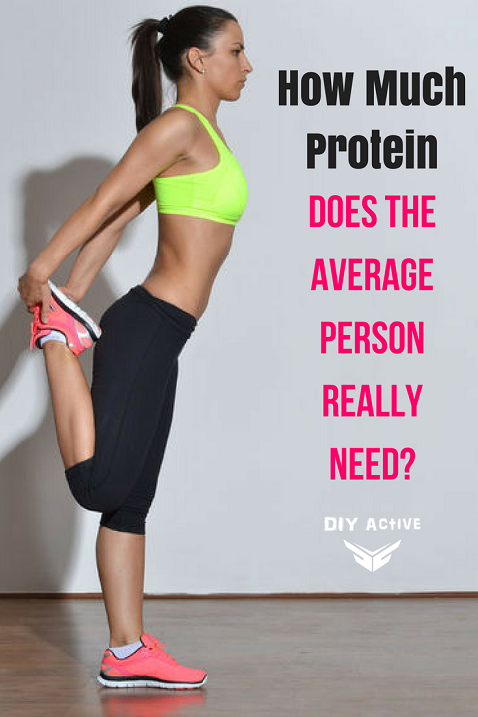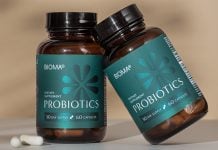
So How Much Protein Do You Need?
Take a deep breath and stop sweating your protein intake. Paying attention to your diet is absolutely vital, but if you are like most people, there’s a pretty good chance you’re focusing on the wrong things.
The Truth About Protein
The average American is eating about 100 grams of protein per day. That is about double the daily recommended intake of 46 grams of protein for adult women and 56 grams of protein for adult men.
That’s right! You’re probably eating more than enough protein as it is to maintain healthy bodily function and support a little muscle growth.
It’s true that after 30 it becomes increasingly difficult for our bodies to retain muscle mass. It’s also true that you need to up your protein intake at least a little bit to build muscle, but it’s a common misconception that you have to skyrocket your daily chicken breast consumption. Most of us are getting close to if not exceeding the elevated protein levels recommended for muscle gain already.
Protein intake isn’t a magic bullet, and there is such a thing as too much. Getting too much protein can lead to serious health risks like digestive issues, kidney damage increased cancer risk and dehydration. It can also lead to unwanted weight gain and bad breath.
 Given that the average American is about 17 pounds overweight, the issue isn’t so much getting the 6-pack as it is taking it out of the cooler. It’s just as important to clean up your diet and reduce body fat as it is to build up the muscles underneath it.
Given that the average American is about 17 pounds overweight, the issue isn’t so much getting the 6-pack as it is taking it out of the cooler. It’s just as important to clean up your diet and reduce body fat as it is to build up the muscles underneath it.
The good news is that you don’t need to eat like a bodybuilder (or power lift like one) to get and maintain healthy, attractive muscle mass.
So, now that we’ve got that weight lifted off your shoulders, let’s focus on quality vs. quantity and fine-tuning your protein intake to make the most of the weights you are lifting.
Get Real About What You Eat Already
You’re on the right track with an at-home workout routine that focuses on strength training and high-intensity intervals to build muscle (you are doing that, right?).
They say abs are built in the kitchen for a reason, so now it’s time to take a look at your diet. Start by using an app like MyFitnessPal to track your food for about a week.
Don’t change anything about the way you normally eat, just go through your day like you typically would but be diligent about documenting every bite of food that you put in your mouth. These apps will calculate the amount of protein you’re already eating.
The reason you want to start there is that it will give you a baseline so you know how much protein you need to add. You can also look for opportunities to swap out healthier proteins.
For example, that steak you had at dinner may taste great but if you’re really focused on your health (including building muscle and protecting your heart) there are plenty of protein-rich foods that are lower in fat and have other benefits like fiber or Omega-3s.
Calibrate Your Protein Intake
Once you have a clear picture of your actual daily protein intake, compare it to the targets below to find the optimal range for your activity level. These references are based on adults of average height and weight.
- Light Activity Level: 0.3 grams of protein per pound of bodyweight
- Medium Activity Level: 0.5 grams of protein per pound of bodyweight
- Heavy Activity Level: 0.7 grams of protein per pound of bodyweight
While you may have heard that you need at least 1 gram of protein per pound of body weight, that’s increasingly seeming like overkill. The literature seems to support roughly 0.5 – 0.75 grams of protein per pound of body weight, and those numbers are generally geared toward bodybuilders and those spending an awful lot of time in the gym.
You can adjust your protein intake to give the best results for gaining muscle and keeping fat off based on your workout routine. For example, if you’re going to be lifting heavy on Monday and Wednesday and doing lighter recovery sets on Tuesday and Thursday you could follow the “Heavy” activity recommendations on your lift days, and the “Light” or “Medium” activity recommendations on your recovery days.
Put together a plan for yourself – consult a nutrition coach if needed – and remember that everyone is going to be a little different. Make sure you stick to a routine long enough to see the results (4-8 weeks) before you change it up.
You may find that you already meet or exceed your daily protein intake when you log your food. While protein is critical for building and maintaining your muscle, you should also take a look at your carbohydrate intake.
Without adequate carbohydrate intake, your muscles can’t efficiently rebuild after your workout either, which can shortchange your gains.
Quality vs. Quantity
Now that you know how much protein and carbohydrates you’re already eating and how much you should be eating, it’s time to fine-tune that diet. Focus on quality ingredients and maintain your energy steadily throughout the day. Aim for clean protein and high fiber carbs.
Here are some simple tips to help you find one that works for you…
- As few ingredients as possible (this is your diet, not chemistry class)
- For animal proteins like whey, egg white, collagen, etc. look for organic and grass-fed
- For plant proteins like pea, hemp, quinoa, soy, etc. look for organic if budget permits
- Look for added benefits like fiber content found in many plant-based proteins
- Avoid added sweeteners and sugars
You might have a couple of protein supplements on rotation, one lower-carb option for earlier in your day and one higher-carb option for post-workout recovery to maximize gains.
Wrap-Up
Truth is that you’re probably already getting a good amount of protein, so only increase as needed (based on the statistics you receive from tracking your current diet) and shift your thinking to quality.
Make sure that you’re choosing the healthiest forms of protein without excessive additives or chemicals. And don’t forget about carbohydrates! They’ve gotten a bad rap over the years but they’re actually important for your muscles, too.
- How Much Protein Do I Need - June 5, 2018


